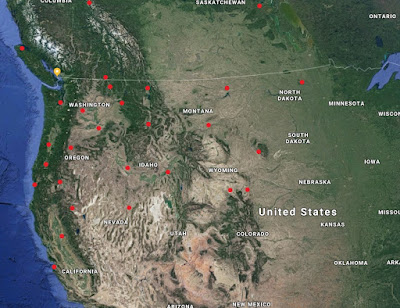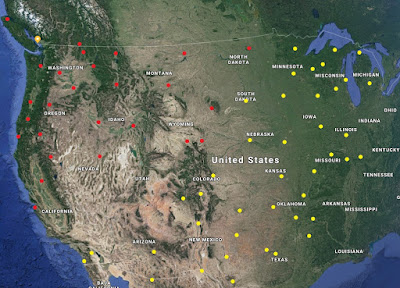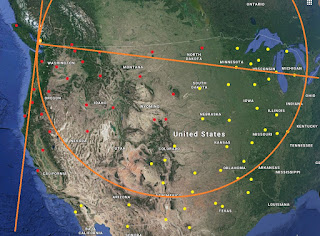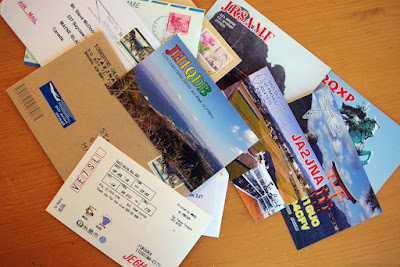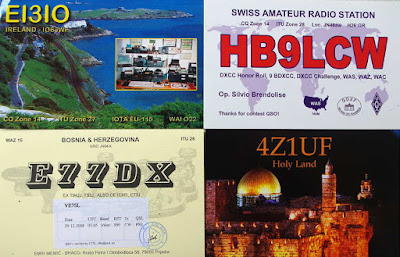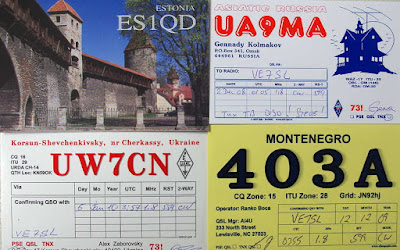Posts Tagged ‘Propagation’
 An Interesting FT8 Afternoon
An Interesting FT8 Afternoon

Lest my loyal blog-followers think I’ve taken a leap to the digital-darkside, rest assured this is not the case!
The only time that I (somewhat grudgingly) use FT8 is during the summer Es season, since most of the DX seems to have migrated to that mode. On Monday afternoon, during a moment of weakness driven by curiosity, I moved my receiver from 630m JT9 to 40m FT8 ... what might I see at around noon, via this popular weak signal digital QSO mode? To say that the results were surprising is an understatement!
 |
| 40m at noon |
With an all-daylight path between VE7 and Asia, could these signals be coming via the long-path? If so, I would expect to see at least a few signals from other countries along the great circle path to Asia but none were forthcoming. Perhaps it’s a case of there being a sufficiently weak D-layer to allow signals to propagate on the direct path via the F-layer, in spite of the all-daylight path. What do you think?
I then moved the receiver down to 80m, and monitored there for the next two hours.
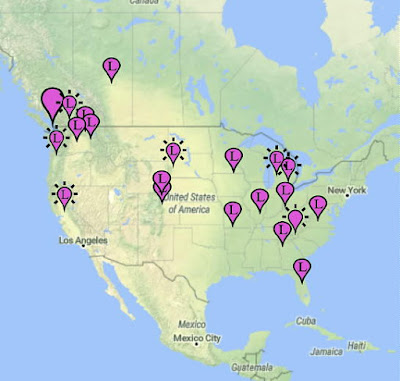 |
| 80m at 1500 local |
For both 80 and 40m, the antenna used was my 80m end-fed half-wave configured as an inverted-L ... 70’ straight up and 60’ horizontal. The feedpoint is one-foot above the ground and located beside the ocean, looking towards the east.
I then finished off the afternoon with a look on topband, using my 160m half-sloper. The screen capture of 160m was made at 5PM local time, fully two hours before my local sunset!
 |
| 160m at 1700 local |
Like the previous two bands, 160m was showing signals in broad daylight, from the east coast! Low D-layer absorption? ... salt water horizon gain? ... excellent antennas? ... or is this just the sensitivity of FT8 revealing 'normal propagation' that we can't hear on CW? I suspect that it's a complex combination of all of these factors and maybe others.
In reality, the weak-signal ‘digging power’ of FT8 is not too much greater than the threshold for audible CW ... hearing about 1 S-unit (~6-7db) deeper. Maybe that’s all it takes to peel-back, like an onion skin, another layer of hidden signals.
There are other weak-signal digital QSO modes much more sensitive than FT8. Both JT9 and JT65 can each hear more than an S-unit deeper than FT8 but at the expense of taking longer to do it ... there’s just no free-ride. I believe that the shorter (~15 second) sequencing of FT8 is the main reason for its overwhelming popularity, in spite of its lower sensitivity.
I’ll run this test again soon to see if Monday’s daytime prop was unusual or if it was typical of what to expect with weak-signal digital modes on the lower bands during the daylight hours ... either way, it was indeed, an interesting FT8 afternoon!
 A Long Listen On 1240 KHz
A Long Listen On 1240 KHz
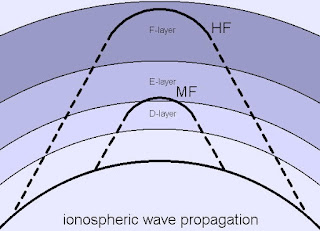 |
| Ionosphere: source |
One of the Broadcast Band’s (BCB) six ‘graveyard’ frequencies is 1240 KHz.
These frequencies (1230, 1240, 1340, 1400, 1450 and 1490 KHz) are assigned to smaller stations running non-directional antennas and up to 1000 watts of power. In North America, there are typically about 150 stations assigned to each frequency.
The origin of this spooky name is often a source of debate. Some suggest that it comes from the cacophony of strange howls and sounds that can be heard on these frequencies at night, as multiple fading signals fight it out to be heard, while others relate it to the similarity of the jam-packed headstones in a typical graveyard. Whatever the true reason, it's a fascinating part of the BCB to explore.
Most BCB DXers enjoy the challenge of tackling the graveyard frequencies as they're often so busy. New stations will fade in for a brief period only to be replaced by a totally different one a few moments later ... and then a different one soon after. It gets even better if the fade-ups coincide with a local ad or a ‘top-of-hour’ ID, putting a new catch in the log!
Several days ago I reactivated my 10’ x 20’ loop and Wellbrook ALA100N preamp, that I use for NDB and BCB DXing, by adding a new buried coax line from the shack.
I had previously re-appropriated the loop’s coax for a nearby HF wire antenna and had been without the loop all winter.
After BCB DXer Mike Cherry (VE7SKA) on Salt Spring Island, the next island to the west of me, described some of the European action that he had experienced last winter, I am determined to not miss out during the next winter's BCB DX season!
 |
| 10' x 20' Loop & Wellbrook ALA100N Preamp |
Once getting the loop powered-up in mid-afternoon, I decided to give it a test by making a ‘deep-search’ on 1240 KHz.
At 1500 hours local time, I wasn’t hearing any audio on 1240 but a weak carrier could be detected audibly. Using my Perseus SDR’s waterfall in its narrowest possible window, produces an extremely narrow passband, effectively increasing the sensitivity by a huge factor. This allows the waterfall to display weak signals that are presently being propagated to my location but far too weak to be heard by ear. I’m estimating that in this narrow bandwidth, it can dig about 30 dB or more into the noise, but there is a price to be paid for this extra gain .... time!
If you're used to watching your receiver’s waterfall scroll along quickly, this mode is just the opposite. It moves in very slow increments, allowing the weaker signals to build up enough to be visible before taking the next deep look. The screen capture shown below is a result of a three-hour listening period, from 1500-1800 hours local time. The entire waterfall is 25 Hz wide, with each tick representing 1Hz.
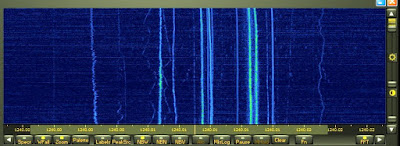 |
| 3-Hour Daylight Deep Search |
Although no signals were clearly audible during this period, my deep-search revealed the carriers of ~28 different stations being received here in south-west British Columbia ... in the middle of a summer afternoon! It’s interesting to note that few of these signals are 100% stable and several can be seen really struggling to maintain their exact assigned frequency. In this highly narrow bandwidth view, even the worst drift amounts to no more than a Hertz, well within the required tolerance of +/- 20Hz.
Using the always-reliable MWLIST, the locations of the most likely candidates for these 28 signals are plotted below. These are the 28 nearest stations and with my loop pointing east, a definite east / south-east flavour is evident.
At mid afternoon, one might expect to see only groundwave-propagated signals on the broadcast band. Midday groundwave on the broadcast band can easily travel a few hundred kilometers, gradually growing weaker over the longer paths. Perhaps all of these signals are arriving via this mode as they are at least 20-30dB into the noise. I initially thought that some of the further-out signals were being reflected from a strong daytime D-layer, although most of the energy would be absorbed. Further reading shows detectable groundwave up to 1200km is possible which coincides nicely with the distances observed. Most likely what I'm seeing is a combination of extended groundwave and D-layer refraction on the furthest signals.
The second screen capture shows the same frequency for another three hours, starting about an hour before local sunset. Some of the weaker signals seen earlier now begin to grow in strength as the D-later absorption starts to decay and reveal the higher E-layer. By the end of the third hour, an additional 41 stations have appeared for a total of 69 carriers cantered on 1240 KHz. (note that my Perseus calibration is off by a few Hz)
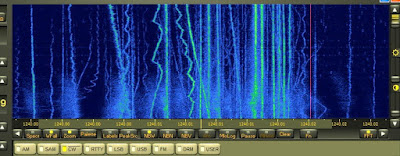 |
| 3-Hour Sunset Deep Search |
The next 41 closest stations are now plotted below in yellow, showing the most likely source of these signals. The distances illustrated are in-line with single and double-hop E-layer or possibly lower F-layer refraction.
This view shows the directional pattern of the front of the loop while pointing east, with its very broad circular lobe. In this direction, the narrow null is only seen along the coast.
It will be interesting to do a mid-winter follow-up on 1240 and compare the present summer propagation to the much better winter conditions. I expect that a some point, propagation via the higher F-layer will be present and extend skip distances out to the east coast or to South America.
In the meantime, things are almost ready for some pre-sunrise looks to the west and some overnight top-of-hour recordings ... as soon as I re-calibrate Perseus!
 Book rather than Blog
Book rather than Blog
My blog has suffered in recent years and here is the reason. For three years now I have been writing a book entitled “Waves with Power-Law Attenuation”. It is now in Springer’s catalogue under classical continuum physics and I’m also very happy that it is published in the Acoustical Society of America Press series.
The emphasis is on models for waves that experience attenuation that follows a power-law in frequency. Topic-wise it is more about mechanical than electromagnetic waves, but analogies are drawn between the two fields as many of the models are the same. Power-law models in electromagnetics are in particular useful for waves in biological tissue, which is indeed also the case for acoustic and elastic waves.
The description starts like this:
“This book integrates concepts from physical acoustics with those from linear viscoelasticity and fractional linear viscoelasticity. Compressional waves and shear waves in applications such as medical ultrasound, elastography, and sediment acoustics often follow power law attenuation and dispersion laws that cannot be described with classical viscous and relaxation models. This is accompanied by temporal power laws rather than the temporal exponential responses of classical models.“
Read more on Springer’s site.
 6m … Where’d The Magic Go?
6m … Where’d The Magic Go?

This summer's 6m sporadic-E (Es) DX season is now well past the half-way mark and things have been different ... a lot different. For me, the past 40 plus summers of activity on the magic band have always been interesting, if not down right exciting ... particularly when the band opens to Europe from the west coast.
These usually very short-lived paths have been my main interest for the past several years and the bread and butter mode is normally a fast CW exchange, usually taking less than 20 seconds before signals would vanish, as the always quirky west coast path to Europe would jump to another region. But this has all changed dramatically.
I have seen many strong openings involving loud FT8 signals from various parts of North America but when tuning down to the CW/SSB section of the band, found nothing but ghostly silence! Gone are the familiar voices of friends met every summer for decades or the recognition of an old friend's fist on CW ... for me personally, most of the magic was missing this summer. I wonder if this is all part of the natural evolution of amateur radio or does the FT8 revolution signal the long term fate for many of the older conventional modes?
 |
| Track the pole's movement here. |
 |
| July 18th courtesy: http://www.on4kst.org/chat/index.php |
 |
| July 20th courtesy: http://www.on4kst.org/chat/index.php |
 |
| Overnight decodes July 8-9 |
BM6GJL PL02
HL1BRU PM37
HL2IFR PM37
BG4QNE PM01
VR2VAZ OL72
BV2FB PL05
BV6CC PL03
BV1EK PL05
BM3GFU PL04
Thanks to Paul, K7CW, for doggedly sorting through my all-night decode file which may be viewed in full here.
With just a couple of weeks left in the normal Es season, it will be interesting to see if FT8's extra few db will extend it longer than usual!
 Will The Sun Get Too Quiet For Topband DX?
Will The Sun Get Too Quiet For Topband DX?

Those of us that like to hunt European DX on 160m from the west coast know that the best time for this is during the 'solar low' years, those quiet periods between the end of one solar cycle and the beginning of the next.
From the west coast, openings to Europe on 160m are not something that happens with much regularity and, unlike the more frequent paths to Europe enjoyed from the east coast, are almost exclusively limited to this quieter part of the solar cycle. The weakening of the Sun's magnetic field at these times allows for less prop-killing D and E-layer signal absorption, particularly through the northern auroral zone path required from the west coast.
In his October, 2016, posting to the Topband reflector, propagation guru Carl Luetzelschwab, (K9LA), suggested that the coming years of solar lows may actually be too low and that because of the likely unprecedented low levels not seen in our lifetimes, the planet could receive higher cosmic-ray bombardment than normally associated with these periods.
"Since galactic cosmic rays are mostly *very energetic* protons, they can get down to low atmospheric altitudes, causing collisional ionization in the D region (and lower E region). A cursory estimate using cosmic ray ionization rates confirms more ionization in the lower atmosphere. 160m is not very tolerant of more absorption, so we may see an adverse effect of the weakened solar magnetic field."
K9LA's Topband comments seems to have its roots in his May, 2015 article, "What's Going On With-160 Meters?", where he compares the solar minimum period between Cycles 22 and 23 to the minimum years between Cycles 23 and 24. Carl noted that the best 160m propagation period that he had seen in his lifetime was during the years between Cycle 22 and 23 and pondered why, during the even deeper prolonged low between Cycles 23 and 24, was it not producing the same levels of great propagation observed 11 years earlier. One possibility he puts forward was that ...
" ... it involves galactic cosmic rays (GCRs). At solar maximum, the Sun is more active, causing more geomagnetic field activity that is believed to be detrimental to 160-Meter propagation. Coupled with the Sun being more active is the fact that the Sun's magnetic field is stronger, which shields the Earth from galactic cosmic rays. Going the other way, when we're at solar minimum, the Sun's magnetic field is weakest, letting in more cosmic rays."
His graph shows the yearly trend of only the low Ap index days (geomagnetically quiet) versus smoothed sunspot numbers for several recent cycles. The blue line plots the trend of low Ap index values with the black line showing the smoothed values; the red line indicates the smoothed sunspot number (solar activity levels).
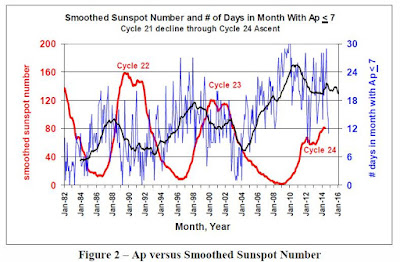 |
| source: http://k9la.us/May15_What_s_Going_On_with_160-Meters.pdf |
Carl's earlier observations indicating that the best 160m propagation he had ever observed was during the low period between Cycle 22 and 23 and not during the much quieter low period between Cycle 23 and 24 are very much different than my own ... perhaps because of our different locations.
From the west coast, the most challenging topband path is over the pole to Europe. This only occurs during 'best propagation' periods as this path will only open during prolonged periods of very low geomagnetic activity. Unlike Carl's path to Europe, west coast signals need to traverse the signal-killing auroral zone.
During the first low period, I did experience several openings to Europe but nothing compared to what they were during the second low period, between Cycles 23 and 24, the one Carl did not experience propagation as good as the previous low. For several winters in a row, during the 23-24 low, I often found night after night of amazing propagation to Europe, the quality of which I had never heard before. Interestingly, on almost all of these nights, there were no other signals on the band but Europeans and nearby Washington or Oregon state W7s ... no signals at all from the rest of North America. At times it mimicked the sound of 20m CW to Europe, with signals often reaching S9 on my FT-1000 S-meter. I even worked one SM station on CW while running just 10W output!
With this long intense low, cosmic ray bombardment should have been at an all time high ... maybe it was, but it didn't seem to be bothering the west coast path to Europe, via the seemingly dormant auroral zone.
I was prompted to address this topic after reading a recent report on the GeoSpace website, siting a new study led by Nathan Schwadron, professor of physics at the University of New Hampshire’s Space Science Center. In the study, recently published in the journal Space Weather, a publication of the American Geophysical Union, the researchers found that large fluxes in Galactic Cosmic Rays (GCR) are rising faster and are on a path to exceed any other recorded time in the space age.
The author's study predicted a 20% increase in radiation bombardment but their newest research shows current conditions exceed their predictions by about 10 percent, showing the radiation environment is worsening even more than expected.
With cosmic ray levels now predicted to increase by a whopping 30%, Carl and the rest of us may soon get some clarity on his original postulation that "maybe a solar minimum can be too deep for 160 meters."
With the next few cycles expected to be even poorer than the present one, the large increase in radiation levels from space may have profound impacts on more than just propagation ... satellites and, with a new appetite to return human activity to the moon, astronauts could be exposed to much higher radiation levels than ever before.
The next few years of (ultra?) solar-quiet should be very interesting!
 Update: Propagation Forecasts for CQ WW (SSB and CW) DX Contest Weekends
Update: Propagation Forecasts for CQ WW (SSB and CW) DX Contest Weekends
Are you participating in this year’s CQ World-Wide DX Contest, either the SSB weekend (this coming weekend, October 28-29, 2017), or the CW weekend (November 25-26, 2017)? The CQ WW is the largest Amateur Radio competition in the world. Over 35,000 participants take to the airwaves on the last weekend of October (SSB) and November (CW) with the goal of making as many contacts with as many different DXCC entities and CQ Zones as possible.
I have updated my forecast on the expected propagation conditions during both the SSB and CW weekends of the 2017 CQ World-Wide DX Contest. I will publish a new update for the CW weekend, when we get closer to that November weekend.
The link to the latest update is: http://cqnewsroom.blogspot.com/2017/10/cqww-dx-contest-propagation-update.html
Good luck!
73 de NW7US dit dit
 Magnitude X8 X-ray Flare of Sept 9 2017 (2nd Biggest in Cycle 24)
Magnitude X8 X-ray Flare of Sept 9 2017 (2nd Biggest in Cycle 24)
The sun erupted with an X8 solar flare, one of the largest of the current solar cycle (Sept. 10, 2017). Its source was the same sunspot region that produced an X9 flare last week. We show this in two wavelengths of extreme ultraviolet light at the same time, and each reveals different features. Both are colorized to identify in which wavelength they were observed. The coils of loops after the flare are the magnetic field lines reorganizing themselves after the eruption. The video clip covers about six hours.

